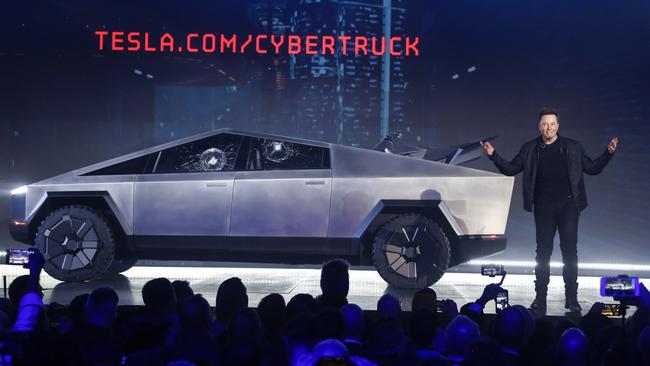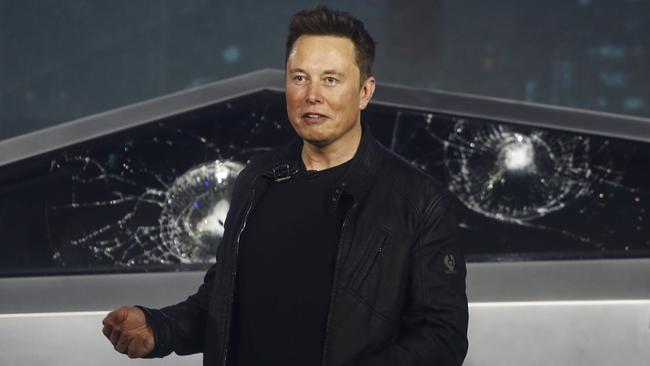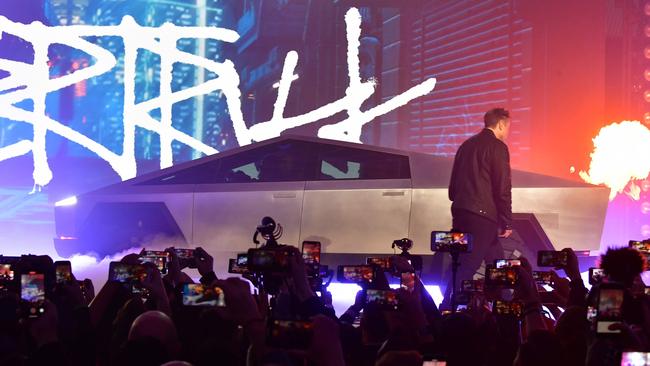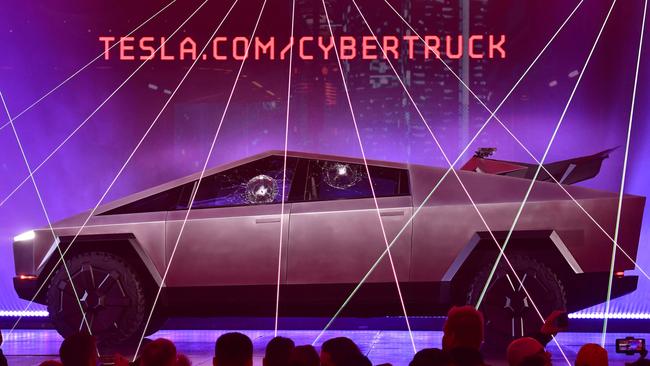Tesla unveiled a bulletproof utility and the window broke
Elon Musk is touting his Tesla electric utility’s toughness but a demonstration was followed by a $1.1bn hit to his wealth.

Elon Musk has embraced unorthodox designs for his Tesla Incorporated’s all-electric pickup truck, or utility vehicle, to wow buyers and help differentiate it from popular petrol-powered models that he knocked as boring look-alikes.
But the features the Tesla chief executive is promising could dent the commercial prospects of the vehicle Mr Musk has dubbed Cybertruck, which was shown to the media late last week. According to Forbes, that pushed Mr Musk’s net worth down by $US768m ($1.13bn) in a single day, to $US23.6bn. Shares in Tesla fell 6.1 per cent on Friday US time after the launch.
Mr Musk on Thursday unveiled the triangular, stainless-steel truck that evoked a science-fiction future. The Los Angeles unveiling focused on showing how robust the vehicle would be and how it would stand out from big sellers such as Ford’s F-150 or General Motors’ Chevrolet Silverado and the GMC Sierra pickup family.
The Tesla pickup was even bulletproof, Mr Musk said.
But when it came to demonstrating the Cybertruck’s toughness, things went ominously off script. Mr Musk asked his head of design to throw a small metal ball at the vehicle’s side window. The resulting crack of the window surprised the audience, including Mr Musk.
“Oh my f---ing god,” Tesla’s chief said. “Maybe that was a little too hard.”

The truck’s unique appearance also caused a stir. The pickup looked like the love child of a DeLorean, the unconventional sports car featured in the Back to the Future movies, and a Pontiac Aztek, which was widely panned as ugly in the early 2000s and became an embarrassment for GM.
Later, DeLorean was even trending on Twitter and some users were digging out past photos of the Aztek.
Tesla may have time for the Cybertruck’s look to grow on consumers. The model is not due out for a while, plus the electric pickup market is nascent. Research firm IHS Markit Ltd projects electric vehicles will account for about 9 per cent of the US auto market in 2026, up from less than 2 per cent today, and pickups would be a subset of that figure.
“There is some time to start to acclimate to it,” said Stephanie Brinley, principal automotive analyst at IHS Markit.
Some fell for it immediately. Twitter was filled with new Cybertruck buyers celebrating their purchase commitments. One user, @WilliamsAinsley, said on Twitter that he had made his down payment. He was planning on buying a Model X, Tesla’s sport-utility vehicle, “but once I saw this new design and the new interface plus the interior that was like, it’s a must have!”

Mr Musk has defied conventional automotive industry wisdom during the past 16 years by demonstrating that hundreds of thousands of people are willing to pay a premium for electric cars. Sleek design was part of the formula, inspiring people to buy a cool car, like the Model S, that just happened to be electric. The pickup aims to follow in the tradition.
As Tesla prepared the pickup, some inside the company worried Mr Musk’s personal taste was overly influencing the design and questioned whether his preferences would be in line with buyers.
In some ways, the Cybertruck’s extreme, aggressive looks coupled with the emphasis on ruggedness conform with trends in the segment. Fiat Chrysler Automobiles NV’s Ram, for example, has pushed the envelope in recent years with its brutish look — and it has been rewarded with increased sales, threatening GM’s Silverado business.
But several analysts said Tesla has gone too far. The Cybertruck, they said, could be relegated to be a niche product, lacking in appeal for the commercial buyers who make up a big part of the pickup population. Dan Levy, an analyst with Credit Suisse, was blunt: “Ford and GM can now breathe easy again.”
Tesla has to cut a new path if it is to win over truck buyers, who tend toward strong brand loyalty. Toyota Motor Corp and others have tried to take market share from the Detroit vehicle makers for years, with little luck. One area where Toyota has found success is in midsize trucks, especially in California, where certain consumers will choose a pickup to run errands and pursue weekend hobbies.
“The market has changed,” said Alan Amici, vice-president and chief technology officer of transportation solutions at TE Connectivity, a supplier to the automotive industry. “You have very affluent buyers who are probably not doing construction work but are using it for lifestyle.”
California is Tesla’s home state and its best US market.
Tesla’s design may provide an alternative for people who don’t like the look or feel of a typical pickup. The top-end model would have the acceleration of a sports car, going from zero to 60 miles (96km) per hour (in 2.9 seconds, Mr Musk said.
Ross Gerber, chief executive of Gerber Kawasaki Wealth & Investment and a Tesla investor, took to Twitter on Friday to praise the Cybertruck. “It’s possible that Tesla just expanded the market for trucks,” he wrote.
Analysts said the Tesla truck could appeal to early adopters and those looking to attract attention.
“With its unabashed looks, we believe the truck will initially appeal to the influencer crowd (celebrities and pop culture) and the `look at me’ crowd,” Joseph Spak, an analyst with RBC Capital Markets, said.
“Call the Cybertruck a Hummer for the green millennial generation, really the ultimate virtue and vice signalling machine.”
In the 2000s, GM’s Hummer brand of large, military-inspired SUVs attracted a following among buyers looking for a flashy ride, until high petrol prices and concerns about the environment led to dwindling sales and the brand’s termination.
Toni Sacconaghi, an analyst for Sanford C. Bernstein & Co., estimated Cybertruck sales could reach 50,000 a year, in the range of annual Hummer sales of between 30,000 and 80,000 vehicles during its lifetime.
“Tesla’s Cybertruck looks weird … like, really weird,” he said in a note to investors. “Which is too bad, because its on-paper specs are insane and the price is very competitive & much better than expected.”
Tesla didn’t skimp on the meat-and-potatoes for pickup buyers. The Cybertruck can tow 14,000 pounds (6350kg) and has up to 16 inches (40.6cm) of clearance, Mr. Musk said.
Tesla often has had an early-mover advantage with its electric vehicles, but not this time. Ford has announced plans for an electric pickup and GM has said its version would be in the market by late 2021. Tesla was vague about when the Cybertruck would be available, but said it would be nearing production around then. Rivian Automotive, a startup based in suburban Detroit, has been working for years on an electric truck it plans to put into production in 2020.

Mr Musk’s decision to go for an unusual structural configuration for the pickup truck could bring new headaches for a company that has struggled to ramp up production of every vehicle it has brought to market.
Pickup design generally entails a body-on-frame approach. Mr Musk likened the Cybertruck to having an exoskeleton that is sturdier and allows for a roomier interior — but that approach could add cost and complexity in building the model.
Tesla said the entry-level rear-wheel drive Cybertruck would sell for $US39,900 ($58,800), with higher-end, more-capable all-wheel-drive versions priced up to $US69,900. Tasha Keeney, an analyst with ARK Invest, a long-term Tesla shareholder, said the prices were competitive and signal that vehicle makers are approaching price parity between electric and combustion-engine vehicles.
But Mr Musk in the past has struggled to achieve the starting price that he initially touted. The Model 3 didn’t first arrive in stores with the long-promised $US35,000 starting price, and it took months of effort and extreme cost cutting to get down to close that price. Most Model S models sell for much more, which makes investors happy.
David Kudla, founder and chief executive of Mainstay Capital Management and a short seller of Tesla stock, questioned Tesla’s ability to make a profit on a vehicle with a bulletproof steel body, armoured glass and such a low starting price.
“That’s just reminiscent of a $35,000 Model 3 that they really haven’t gotten to in a very realistic way,” Mr Kudla said.
The Wall Street Journal



To join the conversation, please log in. Don't have an account? Register
Join the conversation, you are commenting as Logout